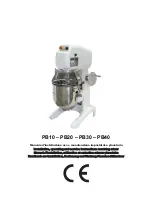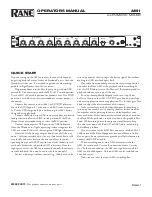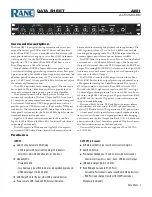
20
WZ20S
User Guide
Stereo Input channel
DUAL INPUTS A and B
The stereo channel features two stereo inputs
with independent gain control and on/off switching. One source may be
selected at a time, or both may be mixed together further increasing the number
of simultaneous inputs to the mix. This means that you can leave two stereo
sources permanently connected to the console without the need to repatch or
readjust the gain settings.
GAIN A (B)
Adjusts the channel input sensitivity to match the connected
source to the console 0dB operating level. This provides a 30dB range with
continuous adjustment for signals from –
20dBu to +10dBu. Use the PFL system
to correctly set the gain using the console meters.
ON A (B)
Switches stereo source A (RCA phono input) and/or stereo source B
(TRS jack input) on and routes it to the channel.
MONO
Combines left and right to provide a mono signal from a stereo source,
or to feed a mono source to both channels.
EQUALISER
The channel equaliser is a powerful tool to creatively tailor the
sound within the mix, or to deal with problems such as poor source
characteristics, noise and feedback. Start with the EQ controls set to their mid
(flat) position. Then adjust the EQ to achieve the sound you want. Take time to
experiment with the controls so you get to learn the effect the equaliser can
have on the sound.
The WZ20S stereo channel provides separate tone control over four fixed
frequency bands. The frequencies in each band may be boosted or cut by up to
15dB. The centre flat position is detented for quick resetting.
HF
Turn this control clockwise to boost and anticlockwise to cut the high
(treble) frequencies. This has a shelving response with all frequencies above
the 12kHz turning point affected. Note that frequencies below 12kHz are
affected by a decreasing amount. Use HF boost to brighten up the sound by
adding sparkle to compensate for poor source material, or cut to reduce source
hiss or high frequency noise.
MF1
Turn the +/- control clockwise to boost and anticlockwise to cut the higher
mid frequencies. This has a bell shaped peak/dip response that has maximum
boost or cut at 2.5kHz. Boost to add presence, or cut to reduce harshness.
MF2
This is similar to MF1 but affects the lower mid frequencies centred on
250Hz. Boosting can enhance the warmth of the sound while cutting can clean
up a boomy sound.
LF
Turn this control clockwise to boost and anticlockwise to cut the low (bass)
frequencies. This has a shelving response with all frequencies below the 60Hz
turning point affected. Note that frequencies above 60Hz are affected but by a
decreasing amount. Use LF boost to enhance low end punch, and cut to reduce
source hum and rumble.
EQ IN
Switches the equaliser in or out of the signal path. Use this to check the
effect of the control settings by comparing the equalised and unequalised
signals
.
ON
-15
-15
-15
60Hz
LF
-15
MF2
MF1
HF
12kHz
-10
-5
0
GAIN
+ 15
+ 15
+ 15
EQ
IN
0
+ 15
0
0
ON
0
MONO
20
15
10
5
GAIN
-10
-5
0
10
20
15
5













































